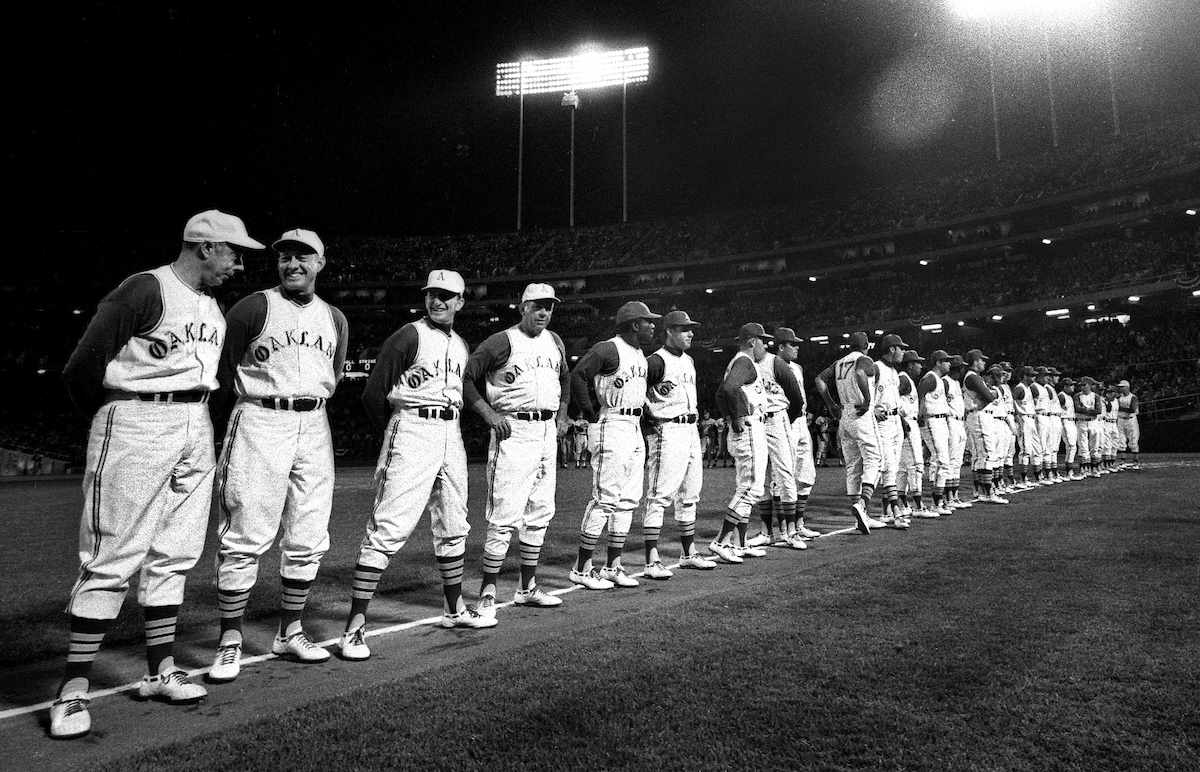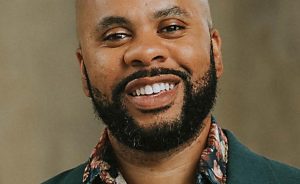OAKLAND — Steve Vucinich could see into the future.
All he had to do was walk outside his home and look toward Highway 880 when construction began on the Oakland-Alameda County Coliseum in 1964. Vucinich had no way of knowing that two years later he’d be selling peanuts for 25 cents and hot dogs for 35 cents as a vendor before ascending to equipment manager when Major League Baseball came to town.
“I lived in the foothills just above there,” Vucinich said. “It was only a two-lane road from there just around MacArthur Boulevard all the way to Hegenberger Road. We were excited because we were Raider season ticket holders and had season tickets at Frank Youell Field.
Steve Vucinich, the Oakland Athletics’ equipment manager, watches the team warm up, Friday, June 25, 2021, at Oracle Park in San Francisco, Calif. (Karl Mondon/Bay Area News Group)
“I was able to watch it go up.”
Approved in 1962, construction didn’t start on the Coliseum until two years later due to cost overruns and legal issues. The Raiders moved from Youell Field, a rickety facility on what is now the grounds of Laney College, to the state-of-the-art $25.5 million Coliseum for the 1966 season.
The Athletics arrived in 1968 when owner Charlie Finley moved the franchise out of Kansas City after 13 seasons. A lower box season ticket cost $269.50 and $115.50 for the bleachers for 77 home dates (including doubleheaders). Gas cost 34 cents a gallon, and a carton of eggs went for 53 cents.
After going 3-2 on a road trip to open the season, the Athletics made their Coliseum debut on April 17, 1968, before a festive crowd of 50,164. Charlie O., a mule mascot named after the Athletics’ owner, arrived with a police escort. Gov. Ronald Reagan, before throwing out the first pitch, asked the crowd if they’d paid their state income taxes and was booed.
The Athletics lost 4-1 to the Baltimore Orioles, scoring their lone run on a sixth-inning homer by Rick Monday. The only other hit was a pinch-hit single in the eighth by a 23-year-old infielder named Tony La Russa.
“I’d never seen 50,000 people in a stadium before,” shortstop Bert “Campy” Campaneris said.
In terms of fan support, reality hit the following evening when John Donaldson drove in Reggie Jackson with a sacrifice fly in the bottom of the 13th inning of a 4-3 win over the Orioles. Attendance was 5,304 and drawing crowds was a problem all season.
“We heard it was going to be a packed house on Opening Night and it was wonderful,” former A’s second baseman Dick Green said. “We didn’t draw much after that, though, did we? We came out here and they were all Giants fans and not too many of ’em switched.”
Sitting in the A’s dugout on the opening night of 1968, Oakland Athletics coach Joe DiMaggio, Cal Gov. Ronald Reagan, and Coliseum Pres. Robert Nahas. DiMaggio was the A’s coach for 68-69 seasons, and Reagan threw out the honorary first pitch. (Ron Riesterer/Bay Area News Group Archives)
Pitcher John “Blue Moon” Odom, born and raised in Georgia, had never been to the West Coast and was spellbound by the Opening Night crowd.
“The first night was unbelievable,” Odom said. “We’d hoped fans would support the team, but they kind of let us down a little bit.”
The Giants had been in the Bay Area 10 years before the Athletics arrived and had established stars in Willie Mays, Willie McCovey, Juan Marichal and Gaylord Perry. The Athletics were coming off a 62-99 final season in Kansas City and had a roster devoid of big names.
The closest thing was the 26-year-old Campaneris, who led the American League in stolen bases three years running in Kansas City.
Finley was penniless when it came to paying his players and had an erratic personality. He told prospective fans at a “Welcome to Oakland” luncheon that he planned to move from Chicago and then never did, running the team by phone. His “million-dollar scoreboard” wasn’t ready until June and various promotions such as “Hot Pants” Day fell flat.
But Finley had a knack for identifying young talent, and the 1968 roster included Catfish Hunter, a 22-year-old holdover from Kansas City, in addition to Odom (23) on the pitching staff, with 21-year-old Rollie Fingers an in-season call-up. Position players included Jackson, Monday, third baseman Sal Bando and catcher Dave Duncan.
Joe Rudi, an outfielder, was an in-season promotion on May 8 and played his first game the night Hunter threw a perfect game.
Oakland Athletics Jim (Catfish) Hunter bears down as he pitches down the last man, Rich Reese, of the Minnesota Twins tonight on May 8, 1968, in Oakland. Hunter struck out Reese for a perfect no-hit, no-run game. (AP Photo/Robert H. Houston)
“I’m playing in left field, had never been to the ballpark in my life and I was praying I wouldn’t screw it up,” Rudi said.
The improvement over the previous year was dramatic, as the Athletics went 82-80-1 (a 2-2 game was ruled a tie because of rain after seven innings).
“We all wanted to be good, and everyone was young,” Odom said. “We thought we could do something with this team. We grew up together. We learned to win together.”
Fingers had no such illusions.
“I got called up late in the season and I was just happy to be there. When you’re a rookie, you don’t say anything to anybody,” Fingers said. “I didn’t say anything to anybody for about two years. But I was in the big leagues, you walk into a ballpark and there are 50,000 seats as opposed to maybe 6,000 in the minors, so it’s a lot different.”
Fingers struggled as a starter before finding himself as a reliever who felt he could pitch every day. Likewise, the Athletics’ style and personality as a team were molded by their home facility. The A’s actually moved the fences 10 feet in after the first year, but there wasn’t much difference.
“Where you play dictates a lot,” Rudi said. “If you took our team and put it in Boston we would have hit a lot of home runs, but here you don’t hit a lot of home runs. People that were around in the late ’60s, early ’70s, I can count on one hand the amount of balls that went out in center field at night. The air was heavy, and the ball just died. We played a lot of low-scoring games with great pitching and good defense.”
Toward that end, the A’s traded Monday, a popular centerfielder, to the Chicago Cubs following the 1969 season in exchange for left-hander Ken Holtzman. Holtzman joined rotation with Hunter, Odom and Chuck Dobson, and the staff got a boost of rocket fuel in 1971 when Vida Blue exploded onto the scene.
It led to championship banners at the Coliseum following the 1972, 1973 and 1974 seasons, with the final out coming in Oakland against the New York Mets in ’73 and the Los Angeles Dodgers in ’74. Yet in those three years, only the 1973 season saw the Athletics break a million attendees with 1,000,764.
The Athletics were still attempting to make headway with the fans, but there was a sense of civic pride in that Oakland believed itself to be a major league city.
Vida Blue and his catcher Gene Tenace embrace between home and the mound after Blue set the Tigers town to win the American League pennant in Detroit on Thursday, Oct. 12, 1972. (AP Photo)
Related Articles
A’s win first game of final homestand at Oakland Coliseum in walk-off fashion
‘I’m going to miss it a lot’: Visiting players, managers bid farewell to Oakland Coliseum
Voices of Oakland: Ken Korach took over iconic job, became Mr. Reliable for A’s radio listeners
A’s owner John Fisher in letter (with typo) to Oakland fans: ‘we tried’
A’s down to three games left at Coliseum after being swept by Yankees
Besides the Raiders and Athletics, the Coliseum was home to the Oakland Clippers of the National Professional Soccer League with the adjoining Coliseum Arena housing the California Golden Seals of the National Hockey League and the Oakland Oaks of the American Basketball Association. The Warriors would eventually move to Oakland from the Cow Palace in 1971 and were rebranded as “Golden State” instead of San Francisco. They would remain there for 47 years until Chase Center opened.
“Plus there was roller derby there too,” Vucinich said. “There was something going on there just about every night.”
The Warriors and Raiders played their final games in Oakland about six months apart in 2019, and now the A’s are leaving five years later. The Oakland Roots and Soul soccer teams will play at the Coliseum next season, but it’s a far cry from the site’s heyday.
“It was a great time,” Vucinic said, “so it’s sad to see what it’s become.”












